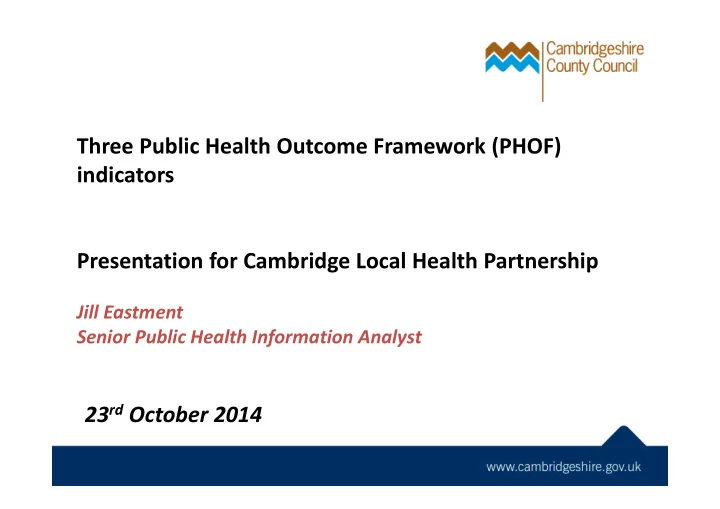

Three Public Health Outcome Framework (PHOF) indicators Presentation for Cambridge Local Health Partnership Jill Eastment Senior Public Health Information Analyst 23 rd October 2014
Background Annual Public Health Report is focussed on new national Public Health Outcomes Framework (PHOF) Three indicators where Cambridge City has statistically significantly high rates compared with England as a whole • Fuel poverty • Injuries due to falls in people aged 65 and over • Hip fractures in people aged 65 and over Further detail was requested at the last meeting of Cambridge Local Health Partnership
Injuries due to falls and hip fractures in people aged 65 and over • Injuries due to falls: rates consistently higher than England average • In 2012/13 rate of hip fractures in Cambridge City was significantly higher than the England average though this has varied over time
Injuries due to fall in people aged 65 and over • Where the primary diagnosis (main reason for hospital admission) is an Injury code and a falls code has been included in diagnoses 1-12 • Around 480 admissions per year (Cambridge City) • 74% in over 80s • 68% in women Source: Public Health England (PHE). Primary diagnosis code for Injury (ICD 10 S00- T19) with falls code (WOO-W19) anywhere in diagnostic string.
Fracture of the hip in people aged 65 and over • Around 130 hospital admissions per year in Cambridge City • 75% in over 80s • 68% in women • Estimate of c30% from care homes • More than 93% are coded as having Source: Public Health England (PHE) Primary diagnosis ICD 10 S72.0, S72.1, S72.2. experienced a fall
Limitations of data • Falls: coding known to be variable between hospital trusts, although this is thought to have improved. Some artefact of coding is likely nationally. • Fractured neck of femur: relatively small numbers at local level for lower levels of breakdown eg by month or by place • Less issues with coding than with falls – fractures coded but similarly there is little further detail in data (eg place, ‘cause’) • Proxy for serious falls • Interest in identifying all fragility fractures (feasability study) but hard to capture eg A&E, primary care • National indicators are based on the resident population. Transfers from other hospitals may be included in nationally produced rates.
Falls coding? • 98% of emergency admissions for injuries due to falls in Cambridge City are to CUHFT (Addenbrooke’s) • Figure shows CUHFT catchment area • Graph shows rates for neighbouring LAs (although only part authorities)
ONS Cluster Group
Seasonality? Source: Inpatient Commissioning Data Set (CDS). Primary diagnosis code for Injury (ICD 10 S00-T19) with falls code (WOO-W18) anywhere in diagnostic string. Note that there is little evidence of seasonal variation in these data although the trend over time appears to be downward.
65+ Emergency admissions for Cambridgeshire 150 injury due to falls Cambridge 400 Number of admissions 2012/13 and 2013/14 pooled 300 100 200 50 100 0 0 Apr May Jun Jul Aug Sep Oct Nov Dec Jan Feb Mar Apr May Jun Jul Aug Sep Oct Nov Dec Jan Feb Mar 150 150 Fenland East Cambridgeshire 100 100 50 50 0 0 Apr May Jun Jul Aug Sep Oct Nov Dec Jan Feb Mar Apr May Jun Jul Aug Sep Oct Nov Dec Jan Feb Mar 150 Huntingdon South Cambridgeshire 150 100 100 50 50 0 0 Apr May Jun Jul Aug Sep Oct Nov Dec Jan Feb Mar Apr May Jun Jul Aug Sep Oct Nov Dec Jan Feb Mar
Type of fall and place of fall (ICD 10)
Electoral ward Source: Inpatient Commissioning Data Set (CDS). Primary diagnosis code for Injury (ICD 10 S00-T19) with falls code (WOO-W18) anywhere in diagnostic string. Error bars represent 95% confidence intervals (CI). CCC Research Group ward population estimates. Note that although there is variation between areas, the difference between electoral wards is not statistically significant.
The older population Cambridge City - resident population • Cambridge City has a higher England Cambridge Cambridgeshire proportion of the older 35% population in the agegroups 30% % of 65+ population over 80 years than both 25% England as a whole and 20% Cambridgeshire 15% 10% 5% 0% 65-69 70-74 75-79 80-84 85-89 90+
Further information • Cambridgeshire Joint Strategic Needs Assessments (JSNA) Older People and Prevention JSNA 2013 – Chapter 5: Falls Prevention . http://www.cambridgeshireinsight.org.uk/joint-strategic-needs-assessment/current-jsna-reports/prevention-ill- health-older-people-2013 • Future work: Falls Prevention Strategy
Cambridgeshire Atlas™ | Fuel Poverty http://atlas.cambridgeshire.gov.uk/Housing/FuelPoverty/atlas.html
Fuel Poverty: Definitions • Previous definition (2009-2011) based on household spending more than 10% of income to maintain reasonable degree of warmth (18-21 degrees C) • Revised methodology – Low Income High Costs (LIHC) households with below average incomes paying above average costs for fuel – Detail in Hills Fuel Poverty Review https://www.gov.uk/government/publications/final-report-of-the-fuel- poverty-review
Fuel Poverty: further resources See also Cambridgeshire Joint Strategic Needs Assessments (JSNA) : Housing and Health JSNA 2013 – Chapter 8 Improve standards in existing homes and encourage best use of all housing stock. Available at: http://www.cambridgeshireinsight.org.uk/joint-strategic-needs-assessment/current-jsna-reports/housing-and-health-2013 FUEL POVERTY: HOW TO IMPROVE HEALTH AND WELLBEING THROUGH ACTION ON AFFORDABLE WARMTH. A guide to delivering action on fuel poverty for public health professionals, health and wellbeing boards, and local authorities in England. UK Health Forum, April 2014. Available at: http://www.fph.org.uk/uploads/UKHF-HP_fuel%20poverty_report.pdf Evidence review 7: fuel poverty and cold home related health problems. UCL Institute of Health Equity. September 2014. Available at: https://www.instituteofhealthequity.org/projects/fuel-poverty-and-cold-home-related-health-problems Briefing 7: fuel poverty and cold home related health problems. UCL Institute of Health Equity. September 2014. Available at: https://www.instituteofhealthequity.org/projects/fuel-poverty-and-cold-home-related-health-problems Barnes M, McKnight A. Understanding the behaviours of households in fuel poverty: a review of research evidence. DECC. July 2014. The Health Impacts of Cold Homes and Fuel Poverty. Available at: http://www.instituteofhealthequity.org/projects/the-health-impacts-of- cold-homes-and-fuel-poverty Marmot review team. 2011.
Contact: Jill Eastment, Public Health Intelligence, Cambridgeshire County Council Jill.eastment@cambridgeshire.gov.uk Polly Jackson, Research Group, Cambridgeshire County Council Polly.jackson@cambridgeshire.gov.uk
Recommend
More recommend